
Entering the European market for wildlife tourism products
European tour operators expect local operators offering wildlife tourism products to operate under high standards and manage their business sustainably. As the world reopens to tourism following the COVID-19 pandemic, local operators must be very clear on how they will keep travellers safe. This is the most important factor that European tour operators and their customers are concerned with in the short term.
The market is very competitive and working alongside communities and local conservation organisations offers many opportunities to local operators to add value to their wildlife travel product and appeal to European wildlife tourists.
Contents of this page
- What requirements must wildlife tourism products comply with to be allowed on the European market?
- Through what channels can you get wildlife tourism products on the European market?
- What competition will you face in the wildlife tourism market?
- What are the prices for wildlife products on the European market?
1. What requirements must wildlife tourism products comply with to be allowed on the European market?
European tour operators that sell wildlife tourism products to European wildlife tourists are bound by strict regulations to ensure the safety of their travellers and to protect them financially. You should understand what these regulations are.
What are the mandatory and additional requirements that buyers have?
The requirements that European tour operators have for wildlife tourism products in developing countries cover the following:
- The European Package Travel Directive
- General Data Protection Regulation (GDPR)
- Liability Insurance and Insolvency Protection
As a first step, you should read the CBI study What requirements must tourism services comply with to be allowed on the European market and familiarise yourself with the legal, non-legal and common requirements.
For wildlife tourism businesses in Africa, SATIB is a specialist broker in tourism and leisure and provides insurance for tourism businesses in many countries across the continent. It offers insurance products for accommodation providers, tour operators and transport/wheel operators, and a range of specialist insurance services that include management of wildlife and habitats.
Adventure Travel Standards
Wildlife tourism trips in developing countries often form one part of an adventure tourism trip and there are many standards that cover safety of participants and tour operators’ management of risk.
The CBI study Entering the European market for adventure tourism has detailed information about standards that many businesses operating in the adventure tourism segment should comply with, including the International Organisation for Standardisation’s (ISO) Standard for Adventure Tourism and the British Standard for Adventure Tourism. These standards are not mandatory but if your business does comply with standardised regulations, buyers are more likely to do business with you.
To complement these standards, the Adventure Travel Trade Association (ATTA) released the second edition of the Adventure Travel Guide Standards (ATGS) in February 2021. This document provides information and support to governments, destinations and tour operators to enhance the quality, safety and responsibilities of adventure travel guides. Sustainability of activities within the adventure travel segment is a key component and the guide makes specific reference to protecting animal welfare and reporting animal abuse.
COVID-19: Preparing to reopen following the pandemic
At time of writing in March 2021, the COVID-19 pandemic continues to have a considerable impact on the tourism industry worldwide. Travel restrictions are set to continue into May in many countries across Europe, including the UK, Germany, the Netherlands and France. European governments continue to advise their nationals against all but essential travel abroad, and countries within and outside Europe continue to impose quarantine periods on inbound travellers.
To stay informed of the situation in Europe you can browse the internet for articles like this one on the BBC website, Covid: How are European countries tackling the pandemic?, which offers up to date information. International travel regulations are changing regularly and to stay informed, you should consult IATA’s interactive travel restrictions map. You should also be aware of the restrictions in your own country and keep checking for any developments.
However, as national vaccination programmes around the world gather pace, the tourism industry is optimistic for recovery in the summer of 2021. Domestic tourism will be the first segment to recover. In the short term, this offers local tour operators the chance to reach out to local markets. This is likely to be followed by increased travel to short-haul destinations. For Europeans this means travel to a neighbouring country on the continent.
Long-haul travel to developing countries is likely to recover more slowly and decisions to travel abroad will depend upon conditions of entry imposed on visitors and safety protocols. Research shows that demand for travel is very high in Europe particularly amongst adventure travellers. A survey in early 2021 amongst British and American tourists found that 70% plan to take a holiday this year but that COVID-19 worries are their biggest concern. Being able to travel safely, being vaccinated, low infection rates in the countries they want to visit and the availability of COVID-valid travel insurance are likely to impact upon travel decisions.
You should use this ‘down time’ to prepare your travel product for a European market that is keen to travel but will need reassurance that there are excellent safety protocols and cleanliness measures in place to keep them safe. You must also establish new booking terms and conditions and clearly state what cancellation and waivers you will offer to your buyers during the pandemic.
Consult the CBI study How to respond to COVID-19 in the tourism sector for tips on preparing for the future recovery of the tourism sector. The study includes detailed information about revising terms and conditions to help you revise yours.
The World Travel & Tourism Council (WTTC) has launched a new set of measures to rebuild consumer confidence, reduce risk and encourage travel to resume. The measures were developed with other partners including ATTA. Some of the measures developed include:
- Reducing numbers of participants to allow for social distancing
- Ensuring activity difficulty levels are not above ability so to reduce the need for rescue services
- Providing clear, consistent and up-to-date communication on health and hygiene protocols
- Providing clear information in advance and on arrival of protocols such as wearing of face masks, hand hygiene guidance and social distancing requirements
- Encouraging online sales wherever possible
- Encouraging guests to handle their own equipment for the whole trip
- Limiting queuing and physical contact wherever possible
You can download WTTC’s Tour Operators - Global Protocols for the New Normal for more details about the measures and decide whether to apply for the ‘Safe Travels’ Stamp Application.
Together with some major international tour operators, ATTA has published a range of insights and frameworks to help local tour operators reopen adventure tourism niches safely, including Wildlife Experiences. Download the guide to see what you can adopt for your business.
For the remainder of this report, all discussion, insight and advice has been provided on the basis of travel in normal circumstances.
What are the requirements for niche markets?
Welfare of animals in tourism
Wildlife holidays are very popular with the European market and visiting wildlife attractions is often a highlight of a trip overseas. But there is increasing negative publicity surrounding the welfare of animals in wildlife tourism and it has become an important issue for European travellers. There are many stories in the press, such as Animals Suffering Unseen – the dark truth behind wildlife tourism by National Geographic, that have considerable influence over Europeans’ perception of wildlife tourism.
According to ABTA, the Association of British Travel Agents, two thirds of people say they are concerned about how tourism impacts on the welfare of animals. Most European tour operators that provide wildlife holidays only work with suppliers that promote very high standards of animal welfare, for both wild animals in their natural habitats or in captivity. Experiences such as elephant rides, wildlife performances, or handling animals and taking photographs or ‘selfies’ with them are no longer considered to be acceptable practices. Images that promote human interactions with a wild animal are unacceptable to European wildlife tourists these days.
If you are a supplier of wildlife tourism experiences, you should know what European buyers consider acceptable. Listed below are some examples of wildlife tourism activities that are widely considered harmful to the welfare of animals which wildlife tourists are actively encouraged to avoid.
Table 1: Unacceptable Practices in Animal Tourism
| Practice | Activities |
| Unacceptable practices involving animals in captive attractions |
|
| Unacceptable practices involving animals in cultural events and activities |
|
| Unacceptable practices involving free-roaming wild animals |
|
Source: ABTA
There are many campaigning organisations in Europe and around the world that actively encourage wildlife tourists to consider what animal experiences they take part in while travelling. This infographic published by the global animal welfare organisation, Four Paws, has issued a simple yet strong message that is easy for tourists to understand and remember.
Figure 1: Think Before You Book!
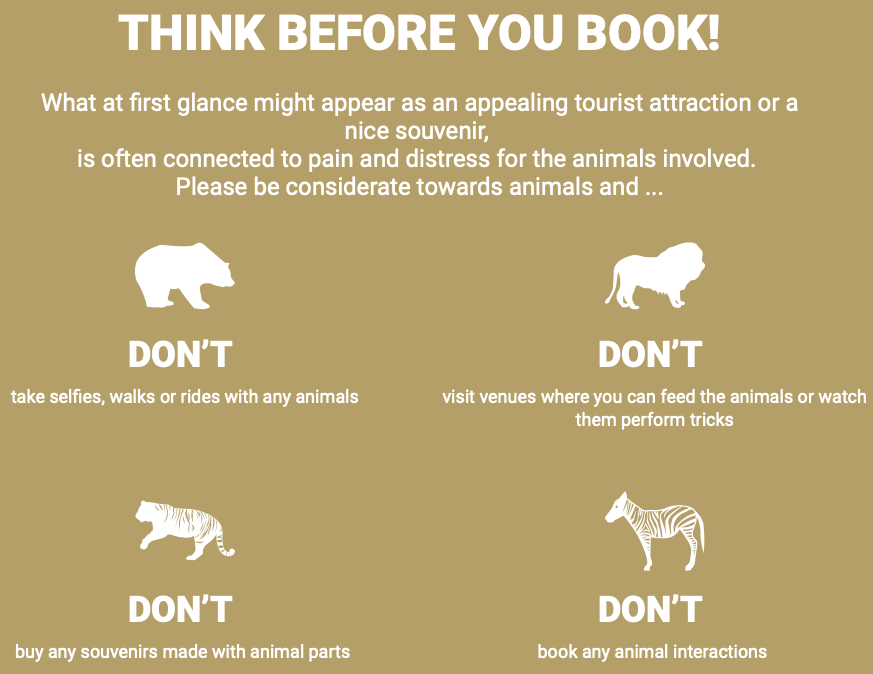
Source: Four Paws
However, many tourism businesses are keen to support the managers and operators of wildlife attractions to implement change, improve the welfare of all animals in tourism and minimise the negative impact on animals and the natural world. ABTA’s guidance and supporting manuals are intended to be practical guides for tour operators to issue to their suppliers, including local operators and animal attractions.
You can register with ABTA to download the free Overview Manual, which offers a comprehensive guide to responsible wildlife tourism. Specific manuals covering topics including Elephants in Captive Environments, Unacceptable Practices and Wildlife Viewing are available to buy, or you can ask your UK tour operator buyers if they are ABTA members and have access to them.
UK operator Responsible Travel is an online directory of responsible and sustainable holidays and it expects tour operators selling wildlife trips on its website to adhere to strict codes of conduct concerning the welfare of animals in tourism. There are several articles to read, starting with Our stance on captive animals, animal welfare and tourism. Other articles cover issues including photos with captive wild animals, wildlife souvenirs and a code for happy horses in tourism.
If you are selling your wildlife experience through an online travel agency (OTA) such as Airbnb Experiences, you must check what their requirements are. Airbnb has an Animal Welfare Policy, developed in conjunction with World Animal Protection, that you should adhere to. Other OTAs have similar codes of conduct. OTAs are well-known for generating business through reviews, which are used by travellers to make a decision about whether or not to visit that attraction. See below how different reviews may influence a wildlife traveller.
Figure 2: Examples of Negative and Positive Reviews of Animal Attractions
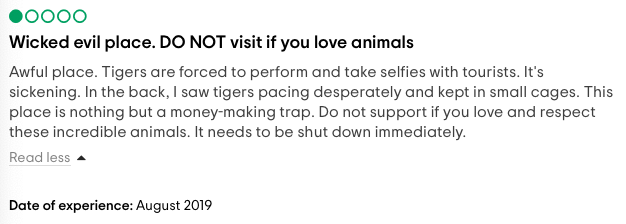
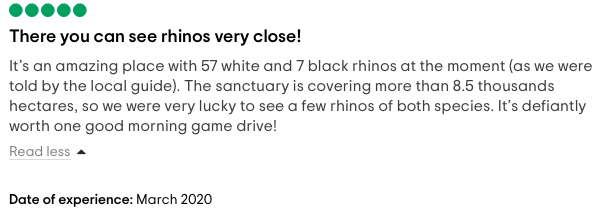
Source: Viator (Tripadvisor)
Both these reviews featured on Viator, which has its own Animal Welfare Policy. The OTA removes products found to be in breach of its policy. In 2019 it announced its commitment to end relationships with businesses breeding or importing whales and/or dolphins for captive establishments.
Tips:
- Read more about the issues surrounding animals in tourism. The European World Animal Protection Organisation’s Checking out of cruelty – How to end wildlife tourism’s holiday horrors is a good place to start.
- Look at the website of the Born Free Foundation, a leading wildlife charity that works to ensure that all wild animals are treated with compassion and respect.
- Make sure you understand what policies or codes of conduct the major European tour operators have about wildlife tourism as they may be your buyers. Read UK operator Rickshaw Travel’s Commitment to Animal Welfare in Tourism and find out about their partnership with animal welfare in tourism experts Animondial, and Germany’s DER Touristik’s Animal Protection Policy.
- Read this article published by OTA Travel Stride about the Ethics of Wildlife Travel – How 6 Top Operators See It.
Sustainability in wildlife tourism
Living through the pandemic has caused many Europeans to re-evaluate what is important to them in their lives. Living and travelling more sustainably in the future has become an important consideration that is likely to transform all elements of the tourism industry in the long term. Sustainability is becoming a bigger factor in travellers’ decision making, and this will affect local tour operators as well. As well as caring about animal welfare, wildlife enthusiasts are also concerned about climate change and sustainability, topics that are attracting increasing attention around the world.
European tour operators will expect their suppliers to operate sustainably and although certification is not mandatory, it is becoming a more common requirement by European buyers. The most commonly adopted sustainable certifications include those which adopt the criteria established by the Global Sustainable Tourism Council (GSTC), such as Travelife for tour operators and travel agents. For more details about sustainability certification schemes, download the CBI study Entering the European market for nature and ecotourism.
This operator from the Netherlands, All for Nature, tells its potential customers directly on its homepage that there are three key things that makes their trip unique – all are concerned with operating at high levels of sustainability.
Figure 3: All for Nature Travel – This Makes Your Trip Unique
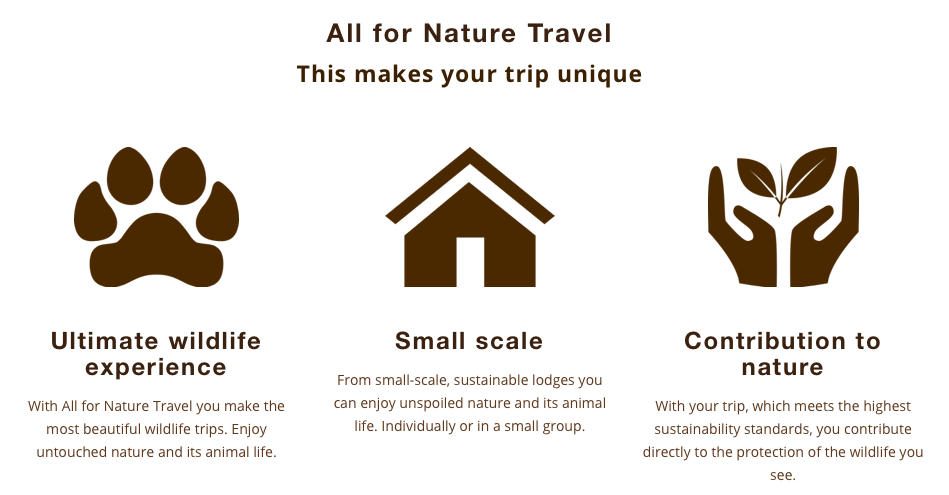
Source: All for Nature Travel
Even if you are not able to become certified, it is a good idea to implement sustainable practices into your business and promote them widely to your buyers and visitors through your website and other sales and marketing channels. Working closely with local communities to protect the wildlife and conserve habitats is among the most important activities that local tour operators can take part in.
Doing so will support your business in the long term and attract visitors who are impressed by your efforts to sustainably support your destination. You can research how tour operators implement sustainability into their businesses. To see what other tour operators do, see these case studies. You can also do your own research.
Adding value to a wildlife experience
The presence of a variety of plentiful wildlife living in its natural habitat, either on land or in the sea, is the main requirement for a wildlife tourism attraction. Viewing animals in their natural habitats in the wild is the most common example of wildlife tourism activities and includes:
Table 2: Typical Wildlife Tourism Activities
| Wildlife Tourism Activity | Animals Viewed |
Wildlife Safaris – 4x4 vehicle, walking/trekking safaris, fly-in safaris, river safaris by canoe, horseback safaris, mountain biking safaris. ‘Safaris’ are usually associated with the African continent
|
|
Marine Life Watching, by boat, to watch marine animals in their natural habitat, feeding, breeding and migrating
|
|
| Other Wildlife Watching – in destinations all over the world |
|
Source: Acorn Tourism Consulting
It is very exciting for European wildlife tourists to view animals in the wild, but it is important that you tell them clearly what they should and shouldn’t do whilst on safari or a wildlife watching trip. Read this blog, 10 Things You Shouldn’t Do When You’re on Safari in Africa, for ideas you can adapt for your own business.
Consider creating some useful instructions for your visitors like these:
Figure 4: Do’s and Don’ts on a Safari in Tanzania
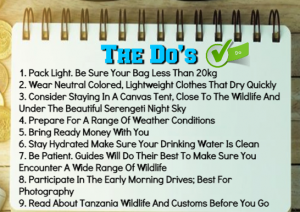

Source: Silver Sky Travel
To create a memorable experience, it is important that guides are well-trained to a high standard. They must be very knowledgeable about the native animals and know the best places to view them, on land or at sea. In southern Africa, the Field Guides Association of Southern Africa (FGASA) offers a range of relevant qualifications for safari guides. Guides should be able to speak the language of the travellers fairly well.
Ensure that you regularly maintain the transport that you use to carry visitors, whether they are 4WD vehicles, minibuses, or boats if your experience is on the water. Drivers and boat captains must be qualified and insured – check your business conforms with all the relevant legislation in your destination.
Adding sustainable activities to your tourism product will add value to your offer. Below are some ideas for you to think about:
- Ensure that any accommodation or lodging is managed sustainably with a focus on using renewable energy sources to provide water, that it has water conserving systems in place, that it uses energy efficient lighting and that it promotes recycling and reusing.
- Ensure that your business employs local people, pays a fair wage and provides appropriate training. This ethos will ensure the local community is committed to help protect the wildlife and conserve their habitats.
- Work with a local conservation organisation to ensure that you minimise the impact of your wildlife tourism product on the local wildlife and environment.
- Food provided should be locally sourced and seasonal.
- Create suitable trails for self-guiding, if appropriate for your destination.
- Develop adventure-themed infrastructure, such as canopy walkways, nature trails, or bird hides.
- Provide suitable information and interpretation sites, such as museums, visitor centres and interactive displays.
- Develop programmes suitable for volunteers that focus on conservation of animals and habitats, and/or projects suitable for academic, educational or scientific research.
- Provide activities and/or educational programmes for children, such as storytelling, painting/drawing animals, bug collecting and animal track identification.
- Make sure you promote your sustainable credentials and activities to your customers and be sure to tell them how they can help. However, be honest about your sustainability credentials and do not exaggerate your performance.
- Provide access to additional activities such as visits to local villages for ‘authentic interactions’ with communities, markets, other local attractions.
- Put up signs to inform your visitors how they should behave around wild animals. See these examples from the Kenya Wildlife Service and the Galapagos National Park.
Figure 5: Rules for Visitors
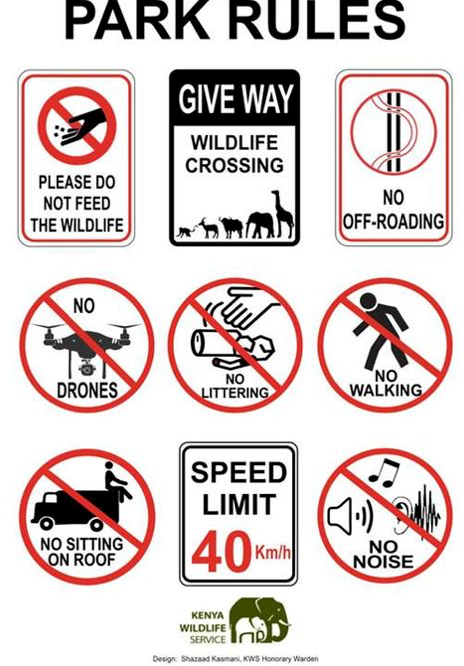
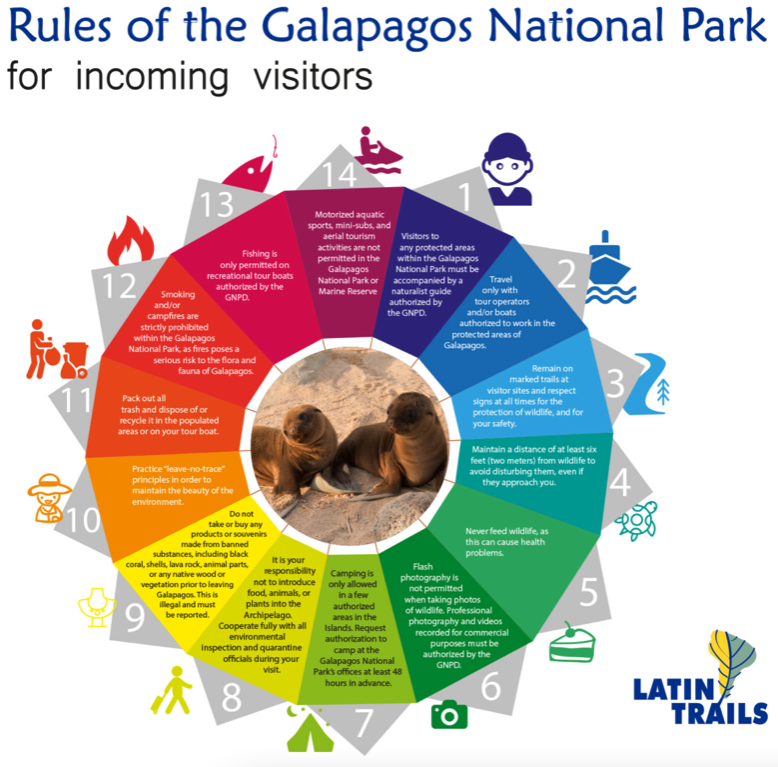
Sources: Kenya Wildlife Service; Latin Trails
2. Through what channels can you get wildlife tourism products on the European market?
How is the end-market segmented?
Wildlife tourism is a very popular activity and it is estimated that up to 40% of all international tourists have an interest in some form of wildlife watching. The main markets from Europe are the UK, Germany and France followed by Spain, Italy and the Netherlands. Wildlife tourists cross over with many different markets, particularly Adventure tourists and Fully Independent Tourists (FITs) and include many ages and generations. They have many motivations for travel and the chart below outlines the broad groups of wildlife traveller and their motivations and typical behaviours.
Table 3: Types of Wildlife Tourists
| Wildlife Tourist Type | Motivations and Behaviours |
| Explorer |
|
| Backpacker |
|
| Backpacker Plus |
|
| General Interest |
|
| Special Interest |
|
| High Volume |
|
Source: Wildlife Watching and Tourism, UNEP/CMS Convention on Migratory Species and TUI
Tips:
- You can read more detail about the market in the CBI studies.
- To find out more about the different markets for European wildlife tourism, download and read the following CBI studies: What are the opportunities in the European Adventure Tourism Market; and What are the opportunities in the European FIT tourism market.
Through what channels do wildlife tourism products end up on the end-market?
Most wildlife tourism trips are arranged through European tour operators who plan entire itineraries or part itineraries and work closely with local ground operators to provide some/all services. Some trips are taken with a guide, while others are taken without a guide. FITs research and plan their own trips, taking responsibility for booking all elements of the trip. FITs may also use tour operators for some parts of their trip, either European operators or local operators on the ground when they arrive. They also use OTAs for day or short trips or experiences. The chart below illustrates the different sales channels to be aware of.
Figure 6: Wildlife Tourism Sales Channels
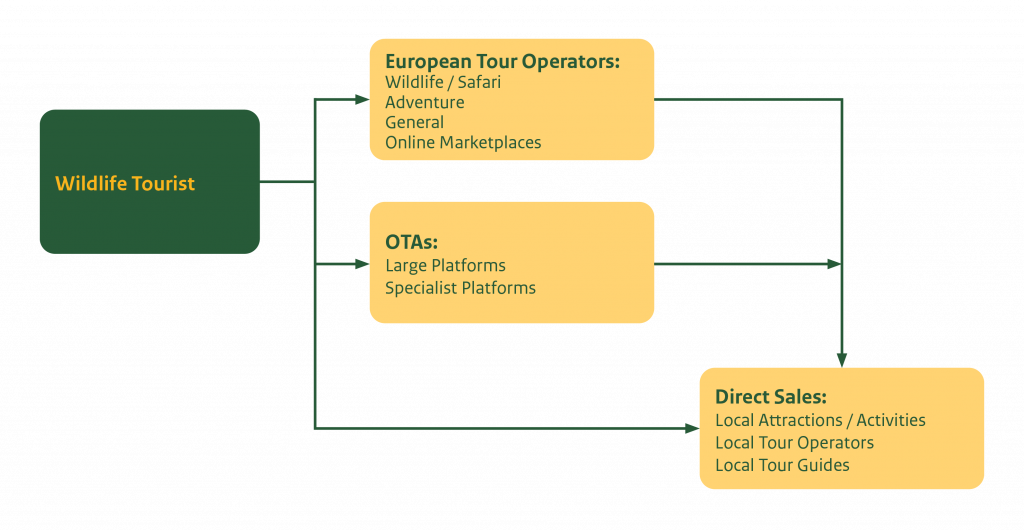
Source: Acorn Tourism Consulting
The sales channels are further described as follows:
- Adventure tour operators – sell a wide range of different trips that involve a variety of activities to a global market, some of which are wildlife holidays. Examples include Explore (UK), Diamir (Germany) and Adeo Voyages (France).
- Specialist Wildlife/Safari Operators – generally only promote trips to view wildlife, for example Kingfisher Safaris (UK) and Wildfoot Travel (UK).
- Online Marketplaces – many European tour operators also sell their holidays through online marketplaces or directories. They are important resources for wildlife tourists who spend time researching where they want to go and what they want to see before deciding where to go. SafariBookings and Responsible Travel are two important platforms. SafariBookings is an online marketplace with almost 3,500 specialised safari operators all over the world that specialise in Africa, selling around 9,500 African safaris. The platform features many thousands of reviews and 200 destination guides.
- Online Travel Agents (OTAs) – allow customers to research and book a variety of travel products and services online, including trips, tours and experiences. Tripadvisor and Viator (which is owned by Tripadvisor) and Airbnb Experiences are among the main platforms for selling attractions and experiences. In 2019, Airbnb Experiences introduced Animal Experiences to its categories of experiences listed.
- Local Tour Operators and Guides – play a major part in the supplier chain, selling wildlife travel products to European tour operators and directly to FITs. A selection of local tour operators are profiled in the section below, Which companies are you competing with?
- Direct Sales – FITs make direct bookings with a wide range of suppliers including accommodation providers, transport, guides and individual attractions.
Tips:
- Do your own research to identify which tour operators travel to your destination to assess whether they could be suitable business partners. To find out more about doing business with European buyers, download the CBI study 10 tips for doing business with European tourism buyers.
- Identify possible partners that don’t have any competing products or experiences in your region
- Identify possibly ways to compliment the tours and experiences being offered by potential partners
What is the most interesting channel for you?
European tour operators, OTAs and SafariBookings (for tour operators specialising in Africa) are the most interesting sales channels for wildlife tourism products.
Direct sales to FITs are also important for you, as they often like to book tours and trips once they have arrived at their destination. You should make sure your website is current and includes measures you have implemented to keep travellers safe as the pandemic eases. You should consider what new features might benefit your website. Download the CBI study How to be a successful tourism company online for a wide range of useful tips to help you.
To join SafariBookings as a Partner, you will need to be a fully registered safari company with the required licenses to operate. There are a number of criteria that you must fulfil to join. Find out whether your business is eligible on the Become a Partner page. A SafariBookings account and review services are free; promoting the business and tours are charged on a payment per quote request. For more information on that, please read How does paying per Quote Request Work.
Tip:
- You can find out the best way to work with OTAs in the CBI study 10 tips for doing business with European tourism buyers and 10 tips for organising your tourism services export to Europe, chapter 2: How to drive bookings with OTAs.
3. What competition will you face in the wildlife tourism market?
Which countries are you competing with?
In the short term, in countries without lockdown restrictions, European wildlife tourists will travel to domestic locations or to short-haul destinations within Europe, visiting countries they are able to travel to without any quarantine restrictions. Travel to long-haul destinations is likely to be limited until the summer/autumn season of 2021, when the pandemic will hopefully have eased sufficiently, and vaccination programmes will have rolled out in the outbound markets to enable more widespread international travel.
Wildlife tourism is common all over the world – the table below offers an indication of how widespread wildlife tourism products are and the many opportunities there are to see them. Therefore, it is clear that wildlife tourism is a very competitive market.
Table 4: Examples of Wildlife Varieties in their Natural Habitats in Africa, Asia and Central and South America
| Wildlife Species Present | Destination, Country |
| Africa | |
| The Big Five – elephant, lion, leopard, buffalo, rhino | Moremi Game Reserve, Botswana Masai Mara, Kenya Kruger National Park, South Africa Madikwe Private Game Reserve, South Africa Sabi Sands Game Reserve, South Africa Ngorongoro Crater, Tanzania Hwange National Park, Zimbabwe |
| Great Migration of zebra and wildebeest | Masai Mara, Kenya Serengeti, Tanzania |
| Many species of iconic African wildlife – elephant, lion, hippo, leopard, wild dog, hyena, cheetah, baboon, buffalo, zebra, gazelle, crocodile | Okavango Delta, Botswana Amboseli National Park, Kenya Samburu National Reserve, Kenya Etosha National Park, Namibia Kgalagadi Transfrontier Park, South Africa Selous Game Reserve, Tanzania South Luangwa National Park, Zambia Mana Pools National Park, Zimbabwe |
| Flamingos | Lake Bogoria National Park, Kenya Lake Natron, Tanzania |
| Cape fur seals | Skeleton Coast, Namibia |
| Gorillas, chimpanzees | Volcanoes National Park, Rwanda Kibale Forest, Uganda Bwindi Impenetrable Forest, Uganda |
| Elephants | Chobe National Park, Botswana Etosha National Park, Namibia Addo Elephant Park, South Africa |
| Lemur including black & white ruffed lemur, blue-eyed lemur, golden bamboo lemur and grey-headed lemur | Rainforests of the Atsinanana, Madagascar |
| Whale watching | South Africa |
| Asia | |
| Bengal Tiger | Ranthambhore Tiger Reserve, India Bandhavgarh National Park, India Kanha Tiger Reserve, India Jim Corbett National Park, India |
| Bornean Orangutan | Kinabatangan River, Borneo |
| Javan rhino, Javan leopard, Sumatran dhole, smooth-coated otter | Ujung Kulon National Park, Indonesia |
| Sri Lankan elephant, Sri Lankan leopard, Sri Lankan sloth bear | Yala National Park, Sri Lanka |
| Asiatic lion, Indian leopard, golden jackal | Gir National Park, India |
| Sumatran rhino, Sumatran tiger, silvery gibbon, Sumatran orangutan, Sumatran elephant | Gunung Leuser National Park, Sumatra, Indonesia |
| Indian rhino, South Asian river dolphin, Bengal tiger, Indian elephant, Asiatic black bear | Kaziranga National Park, India |
| Central and South America | |
| Squirrel Monkey, black-handed spider monkey, mantled monkey, white-faced capuchin | Corcovado National Park, Costa Rica |
| Giant leatherback, hawksbill and loggerhead turtles | Tortuguero National Park, Costa Rica |
| Jaguar, black caiman, green anaconda, howler monkey, South American tapir | Pantanal, Brazil |
| Penguins, Galapagos land iguana, giant tortoise, whale shark, hammerhead shark, Galapagos sea lion, blue-footed booby | Galapagos Islands, Ecuador |
| Whales, sea turtles, sea lions, sea birds | Sea of Cortez, Mexico |
Source: Acorn Tourism Consulting
All the countries featured in the table above should be considered as competing destinations. Profiles of the following countries are provided as key competitors:
- Costa Rica
- Galapagos Islands
- India
- Kenya
- South Africa
- Uganda
Costa Rica
Costa Rica is one of the world’s best-known destinations for ecotourism and responsible tourism – wildlife tourism forms a major part of its adventure tourism offer. It has incredible biodiversity, numerous conservation initiatives and an exceptional number of protected areas for flora and fauna (wildlife). More than half of the 3 million overnight tourists visiting Costa Rica visit one of the 29 national parks or biological reserves, the most popular being Manuel Antonio, Poás Volcano and Tortuguero National Parks. A further five protected areas and wildlife refuges are due to be given National Park status.
Costa Rica was the first country in Latin America to ban hunting as a sport, and farmers are encouraged to use preventative methods to keep predatory big cats away from their livestock, such as electric fences, motion-sensitive lights and noisy donkeys. In 1997, the tourism industry established the Certification for Sustainable Tourism (CST) scheme, a tailor-made certification scheme for accommodation providers and tour operators. The scheme was awarded GSTC-Recognised Standard status in 2020 meaning the scheme’s standards operate to an internationally recognised standard.
Costa Rica is also a popular destination for volunteering projects in the field of animal and marine conservation. Typical programmes include collecting data, protecting turtle nesting sites and accompanying researchers and professional conservationists as they conduct their daily jobs.
Galapagos
The world-famous Galapagos Islands are a UNESCO World Heritage Site. They have a unique ecosystem and an incredible diversity of wildlife species, many of which are unique to the Islands (endemic), including the giant Galapagos tortoise and Galapagos penguin. Tourism to the islands has flourished with visitor numbers growing every year, reaching more than 270,000 in 2019, driven by the growth in land-based visitors which now outnumber ship-based tourists by three times.
Managing tourism sustainably is the most important factor for the Galapagos Islands. The size of boats is restricted to a maximum of 100 passengers and the number of ships has been capped for many years. The most responsible boat operators and tour operators are certified by Smart Voyager, the sustainable tourism certification scheme for South America created in partnership with the Rainforest Alliance. Strict rules are in place to keep invasive species away, including biosecurity actions like fumigating aircraft, keeping to marked trails and never touching the animals. All guides are local and by law must be fully trained by the Directorate of the Galapagos National Park.
While tourism revenue helps to protect the national parks and generates income for local communities, such significant growth in land-based tourism has led to concerns of invasive species, illegal fishing, litter and harm to wildlife. The local authorities are investigating ways to regulate land-based tourism more effectively into the future.
India
India is a key destination for wildlife tourism and the country is particularly well-known for the iconic Bengal tiger. India began protecting these tigers in earnest during the 1970s and the understanding that tigers are more valuable alive as a tourism asset is increasingly recognised by local communities. Killing tigers is now illegal and there are a number of campaigning organisations and tour operators that help to promote sustainable tiger tourism, such as TOFTigers. The organisation has established two certification programmes for accommodation providers. The scheme measures the footprint of lodges and hotels in India’s wilderness areas as either nature-friendly or eco-friendly.
There are around 50 tiger reserves in India and many more national parks home to a great variety of wildlife. Within easy reach of Delhi and Jaipur, the Ranthambhore Tiger Reserve in Rajasthan is India’s premier destination for tiger tourism, attracting almost 500,000 annual visitors, of which 32% are international visitors. Bhadhavgarh Madhya Pradesh is known for its large population of Bengal tigers. In the state of Assam, the Kaziranga National Park is home to two-thirds of the world’s one-horned rhinos while in Gujurat, Asiatic lions live in the Gir National Park.
Wildlife tourism in India is growing in popularity at an estimated rate of 15% among both international and domestic tourists. Some interesting research conducted with visitors to the three major parks of Nagarahole, Kahna and Ranthambore indicated the importance and value of wildlife to visitors. 71% said wildlife was the main reason for visiting; if no tigers were present in the parks, only 34% would choose to visit.
Kenya
Kenya has a long history as one of Africa’s leading safari destinations. It has some of the best places to view wildlife, including the Masai Mara National Reserve, the site of the annual Great Migration of more than 2 million zebra and wildebeest between Kenya and the Serengeti in Tanzania in search of new grasslands and water. Other important wildlife watching parks include Lake Nakuru for huge flocks of flamingos feeding at the shallow soda lake; Mount Kenya National Park, a UNESCO World Heritage Site; Amboseli National Park at the foot of Mount Kilimanjaro in Tanzania; and Aberdare National Park which is home to rare species of rhino.
Kenya’s 23 national parks and 28 national reserves are managed by the Kenya Wildlife Service (KWS) and around 8% of the country’s landmass is protected for wildlife conservation. Increasingly, Kenyan communities are taking a major role in providing safaris as custodians of the land and wildlife through the development of conservancies, estimated to account for 11% of Kenya’s land.
Rather than pay by tourist numbers, safari companies pay annual fees to lease the conservancy lands from local communities, building lodges and other tourism facilities and providing employment to local people. This ensures a more sustainable future for the community owners of the land, the wildlife and habitats. There are now 167 conservancies in Kenya; in the Masai Mara, 15 conservancies now protect more than 450,000 acres of wildlife habitat and lion populations have begun to recover. On the Lewa Conservancy, nine tourism properties, each managed by separate communities, provide conservation-focused safari experiences.
Europe is the key regional market for tourism to Kenya, with leading source markets being the UK, Germany, France and Italy. Before the pandemic, growth to Kenya was sustained as a result of political stability, and the trend for FIT travel was gaining popularity, accounting for 36.1% of international visitors to the country.
South Africa
South Africa is one of the best safari destinations in Africa and there are several state parks and private game reserves that are home to the Big Five. SANParks manages 22 national parks including Kruger National Park, the country’s flagship park, part of which is a designated UNESCO Biosphere. Straddling Botswana, the Kgalagadi Transfrontier Park occupies a huge area that lies in the Kalahari Desert and features seasonal animal migrations.
More than 500 elephants live in the Addo Elephant National Park along with rhino, while crocodiles and meerkats live together naturally in the Mapungubwe National Park, a scenic region of woodland, forest and sandstone outcrops. The continent’s oldest proclaimed nature reserve is the Hluhluwe Imfolozi Park near Durban, home to a large population of white rhinos that was brought back from the brink of extinction through an impressive conservation effort.
Notable private reserves include the Sabi Sands Game Reserve which shares an unfenced border with Kruger National Park, the malaria-free Madikwe Game Reserve and Phinda Private Game Reserve that supports seven distinct ecosystems.
Responsible wildlife tourism in South Africa has been growing in recent years as conservationists and communities work together to develop long term wildlife conservation programmes that make a positive impact on wildlife conservation and community cultures. Community-owned reserves such as the community-owned Tembe Elephant park, established in 1983 to protect a free-ranging elephant population, are on the rise. The Somkhanda Game Reserve (profiled below) is one of the largest and most successful projects where land was returned to community ownership.
To support responsible and ethical wildlife tourism, the South African Wildlife Tourism Association (SAWTA) was established by professionals in the South African wildlife tourism industry, creating an industry standard promoting best practice in support of sustainable long-term conservation. With the strapline ‘We choose well-regulated and managed captivity above extinction!’, SAWTA manages membership, certification and accreditation programmes for captive wildlife facilities, wildlife reserves and farms, parks and zoos, tour operators and other organisations and services that focus on wildlife and conservation.
Uganda
Uganda is home to more than half the world’s endangered mountain gorillas, who live in the Bwindi Impenetrable National Park on the border with Rwanda. Tourism in this area has been regulated and well managed to ensure the safety of the 11 gorilla families that are habituated for tourism. Tracking permits are limited on a daily basis for a maximum of one hour and prices to visit are high, as these funds are needed to protect the parks and the gorillas. The region is also home to a number of community-owned and managed lodges.
In Uganda, wildlife is valued as a major driver of tourism. The Uganda Wildlife Authority conserves and manages 10 national parks and 12 wildlife reserves, along with five community wildlife management areas and 13 wildlife sanctuaries. Murchison Falls and Queen Elizabeth National Parks are good destinations for wildlife – with Queen Elizabeth being home to tree climbing lions. Chimpanzees can be tracked at several locations including Queen Elizabeth National Park, Budongo and Kibale Forest National Park. Uganda is also one of the world’s best destinations for bird watching. The Ziwa Rhino Sanctuary offers tracking by foot to view the rare white rhino.
In response to COVID and to encourage visitors back, the Uganda Wildlife Authority is currently offering discounts off entry fees to its parks and gorilla and chimpanzee tracking permits.
Tip:
- Conduct your own internet research to find out about responsible wildlife tourism within your region or destination.
Which companies are you competing with?
Europe has been hit very hard by COVID-19 and is one of the worst affected regions in the world. You must work hard to reassure European travels that you have robust cleanliness protocols in place to keep them safe. It is essential that you are very clear about the measures you have introduced and specify what they are on the homepage of your website or provide a prominent link to a special COVID page.
You can see how European tour operators feature detailed and clear information about how they will keep their customers safe, and in many cases it is the first thing that visitors see when they click through to the homepage. Look at these examples:
- Yellow Zebra Safaris (UK) – ‘Book with confidence’ is a strong call to action to reassure customers.
- Netherken Safaris & Tours (Netherlands) – see the green banner at the top of the page that links through to more detailed information.
- Aufsafari (Germany) – features a similar orange banner, ‘Safety in Corona Time’.
- Continents Insolites (France) – includes its COVID information within the ‘News’ section.
- &Beyond (South Africa) – has a designated COVID tab on the top navigation.
- Viator (Global) – its measures to keep customers safe and plans flexible are displayed immediately on the homepage.
Companies in Costa Rica
Sukia Travel offers a range of wildlife and adventure packages that are ‘inspirational’ and ‘off the beaten track’ in two destinations, Corcovado National Park and Drake Bay. The operator is managed by local guides and naturalists who are experts in their fields, knowing where to go in remote wilderness areas and how to find animals. The website is bold and easy to navigate with links to videos and testimonials/five-star reviews from happy customers. In response to COVID-19, the operator is encouraging potential customers to sign up to view the discounts on its trips and receive a guide on travelling safely during the pandemic.
The Divine Dolphin offers dolphin and whale watching tours in Drake Bay on the Osa Peninsula of Costa Rica, a biologically diverse area. It is a highly regarded responsible tour operator that has been awarded the World Cetacean Alliance’s Responsible Whale Tour Operator designation and Terra Incognita’s Top Costa Rica Responsible Eco Tour Award. Tours are conducted in custom vessels with on-board hydrophones to hear the dolphins and whales and accompanied by experienced guides and marine biologists dedicated to conservation and preservation.
Proyecto Asis is a wild animal rescue centre and sloth sanctuary that offers volunteer opportunities, educational trips and wildlife tours. Trips are of varying length and accompanied by trained naturalists who speak either English or Spanish, and there are several educational programmes aimed at individuals, families and groups. Trips can be combined with volunteering activities such as getting involved at feeding time or creating environmental enriching activities for the animals. There is also an option to stay overnight in a homestay with a local family, offering an authentic Costa Rican family experience.
The website features a wide range of information, including a blog to educate called Correct Photos vs Incorrect Photos of Wild Animals, which explains why wild animals should never be handled by people for the purposes of leisure photography. Located in the Arenal Volcano area of Costa Rica the centre was awarded Tripadvisor Travelers’ Choice award in 2020 and rated ‘Excellent’ by almost 1,500 travellers, with both accolades featured prominently on its homepage. The centre reopened in November 2020 following the pandemic.
Companies in the Galapagos
Galakiwi is a land-based tour operator in the Galapagos that operates sustainably, ensuring that its tours support local people and minimising its impact on the environment. All tours employ local guides and boat operators, stay in accommodations that are family-owned and operated and eat at local restaurants that serve locally sourced ingredients. In addition, the operator supports projects that eradicate invasive species or clean up beaches. As well as trips for individuals and families, the operator also aims its tours at student groups and educational tours that are typically tailored to the individual traveller, lasting anywhere from three days to three months. Tourism resumed to the islands in August 2020 and in October, Galakiwi received WTTC’s Safe Travel stamp.
Scalesia Galapagos Lodge is situated in the highlands of Isabela Island and offers lodging and tours on Isabela Island as well as island hopping tours to Santa Cruz, Floreana and San Cristobal. It operates and manages all the tours and lodges so it can ensure a high standard of service. Activities included on its tours include kayaking, snorkelling, surfing, bird watching, biking and trekking.
Based on Floreana Island, local operator Nature Galapagos prominently displays a link to a COVID-19 hub on the homepage along with the WTTC Safe Travel stamp. The operator has included a set of highly inspirational images and scrolling text to encourage visitors back to the Islands and features a strong call to action through a blinking chat box. It offers a wide range of trips that are land-based, cruises and diving tours, as well as a range of cruises for different budgets from luxury to budget. The website is available in several languages, namely English, Spanish, Portuguese, French, Italian, German and Russian.
Companies in India
Chinkara Journeys is based in the ‘secret heart’ of Central India, in Raipur, the capital of the new state of Chhattisgarh which was created in 2000. Its eco-friendly wildlife trips are focused on India’s Big 5 – tiger, leopard, sloth bear, wild dog and bison, and destinations include the tiger reserves at Kanha, Ranthambore and Bandhavgarh. The operator’s home page features a helpful interactive map showing the national parks and attractions that gives the visitor useful information at that point. It also links to its Facebook page and has customer testimonials. The operator is a member of Responsible Tourism meaning that it adheres to responsible and sustainable tourism.
Nikita Holidays has a wide portfolio of trips including tiger tours to Ranthambore Tiger Reserve that range from one-day trips to multi-day trips. Guides are provided in several languages – English, French, German, Russian, Spanish, Italian, Chinese and Japanese. The operator sells its tours on Viator and has been awarded the Badge of Excellence, which is awarded to experiences that have met the highest quality standards and are well reviewed by travellers. In addition, the operator is featured on Lonely Planet and OTAs Expedia, Tripadvisor and Get Your Guide.
Shikhar Travels sells a range of trips in India, including 30 wildlife tours in several regions. The operator has won many awards, including India’s Best Adventure Tour Operator in 2018, and is recognised by the Ministry of Tourism as an inbound tour operator. It is also a member of a number of associations, including the Adventure Tour Operators of India, ATTA, TOFTigers and the Indian Association of Tour Operators. It is important that you consider joining relevant associations in your destination. Shikhar Travels offers its customers a clear infographic that features on most pages that clearly highlights the reasons travellers should book with them. You could consider adding something similar to your website.
Figure 7: Why Book With Us?
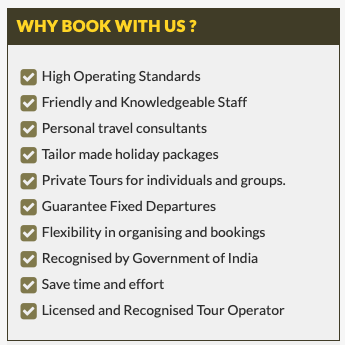
Source: Shinkhara
Companies in Kenya
Porini Safari Camps is a range of eco-camps located in different private wildlife conservancies throughout Kenya, including Ol Pejeta Wildlife Conservancy, home to the world’s last remaining two northern white rhinos, and the Ol Kinyei Conservancy in the Serengeti-Mara ecosystem. Each camp is small, remotely located and activities include guided walks accompanied by local Maasai warriors and night-time game drives. The camps have reopened following the pandemic and there is detailed information about the measures taken to keep visitors safe, including a video called How our camps are Covid-19 prepared. As well as Tripadvisor awards, the camps are Gold Eco-Rated by Ecotourism Kenya (EK), a Kenyan ecotourism society that promotes responsible tourism. Porini Camps have also received WTTC Safe Travel stamp.
Established in 1996, Il Ngwesi is a Maasai owned and managed community conservancy bordering the Lewa, Borana and Lekurruki conservancies. Profits from the lodge along with strong partnerships with local organisations support community projects which ensure that wildlife and habitats are managed sustainably.
Il Ngwesi is supported by the Northern Rangelands Trust (NRT) and endangered species supported include the African lion, wild dog, elephant and the Grevy zebra that is only found in northern Kenya. The lodge is also community owned and managed and guests can get involved in cultural activities such as spending time with local women learning beading, visiting a local health clinic or rhino sanctuary, and learning traditional hunting techniques.
Based in Nairobi, Perfect Wilderness Tours and Safaris offers a variety of activities ranging from one day to 21 days, which include safaris, hiking and biking trips, and climbing trips to Mount Kenya. It has included its updated COVID-19 cancellation policies on every page, which is a good idea for keeping customers informed, and the website features useful information about each of the parks included in its itineraries to help its visitors make a choice. The operator sells its trips on Viator.
Companies in South Africa
After 10 years in the making, the community-owned Somkhanda Game Reserve in northern KwaZulu-Natal is full of wildlife, including the Big Five, and occupies 12,000 hectares of hills and natural bushland. It focuses its conservation efforts on improving ecosystem management and protecting endangered wildlife threatened by poaching and illegal trade.
Owned by the Emvokweni Community Trust (ECT) representing the Gumbi community and co-managed by WILDLANDS, the community receives 10% of all tourism income which is allocated to schools, creches, clinics and small business opportunities. Employment opportunities include conservation ecotourism initiatives, wildlife and cultural experiences. Accommodation is offered through a mix of a lodge property and campsites, including one for wild camping in an unfenced area.
Viva Safaris offers value-for-money safaris to Kruger National Park and is a self-sufficient operator, running all the tours themselves and owning their own lodges and fleet of customised open safari vehicles. The Viva Safaris website opens with a pop-up window advising potential customers of the current situation in South Africa with a link to the COVID-19 page on the South African government website.
This is a very good idea for local tour operators, as it tells customers that they understand the concerns they might have and the need to be fully informed before travel. On the home page it is clear that the customer can ‘Book with Confidence’, knowing they will be able postpone their trip for any reason, with no penalty. The website uses many inspirational images and videos to stimulate interest. Its lodges have won numerous Tripadvisor awards, some included in the Tripadvisor ‘Hall of Fame’, which features businesses who earned Certificate of Excellence for five years in a row. (The Certificate of Excellence was replaced by the Travelers’ Choice award in 2020.)
In addition to safari trips of varying durations, the operator also offers a 14-day scheduled volunteer safari programme, advertised as an exciting way to enjoy Africa’s unique wildlife and make a meaningful impact on local people’s lives. Volunteers get involved in a variety of projects including cement block making, looking after day-old chicks, fish farming, weaving, education, sports coaching and building projects. Viva Safaris is listed as a Top-Rated Operator on SafariBookings.
The Mzansi Experience promotes safaris in the Kruger National Park and Pilanesberg Game Reserve. There are safaris for every traveller type, such as Big 5 Camping Safaris, Big 5 Backpacker Safaris, Big 5 Tented Safaris and Big 5 Luxury Tented Safaris. It also promotes a range of Big 5 Walking Safaris which involve a series of hour-long walks during the trip, always accompanied by an experienced armed guide. All guides are FGASA-certified.
The operator also features COVID information prominently on its home page. The homepage banner features a selection of exciting videos of African animals which is a highly effective way of inspiring potential customers. Mzansi Experience lists its tours on SafariBookings, TourRadar and Stride Travel, and is a member of SATSA and the South African Youth Travel Confederation (SAYTC). It is also a member of Trust My Travel, a financial organisation that protects clients’ funds in the event of financial failure.
Companies in Uganda
Bamboo Ecotours promotes sustainable, eco-friendly and ethical gorilla trekking in the Bwindi National Park. Based in Kisoro village on the Uganda-Rwanda border, it also conducts gorilla and chimpanzee trekking tours across the borders in Rwanda and Congo. The operator is a Ugandan social enterprise established to promote tourism as a way to create economic stability for local communities.
Its trips and tours are designed to give travellers a unique and authentic experience while directly benefiting the local communities who live in the area. 15% of the income generated is invested in local projects such as building schools and health centres. Local communities take an active role in providing cultural tourism experiences and the operator also provides business training to encourage sustainable business practices. Guides and drivers are fully trained and recruited from local communities living around the parks.
There is a link to COVID-19 information clearly evident on the homepage and a pop-up window currently offers 10% off 1-3 days gorilla treks. The COVID page is regularly updated with information for visitors on cancellations and rescheduling trips. It also features updates on how the operator is supporting the families, tour guides and porters in the local community while tourism is on hold.
Africa Wild Explorations is a family-owned Ugandan operator promoting luxury, responsible safaris in East Africa, including Uganda, Rwanda and Eastern DRC. It has a small-group policy and client safety is the operator’s prime concern – every client is signed up to the AMREF Flying Doctors Rescue Insurance Plan for emergency interventions.
The operator founded the NGO Care for Rangers to support rangers as they conduct their roles to protect wildlife from poachers, and donate US$100 from every safari trip to the organisation. Its website includes many inspiration images and each itinerary is fully detailed with additional images of the animals and accommodations. Some of the tours offered include a research element, such as monitoring lion numbers and habituating chimpanzees.
Bright Safaris Uganda organises eco-friendly safaris in order to raise funds to provide basic care and education to orphans and vulnerable children through the Bright Orphan Project, a charity managed by the operator. Bright Safaris caters for many different traveller types including families, couples, solos, students and corporate groups, offering wildlife trips and gorilla trekking, cultural encounters and adventure experiences.
The operator is fully registered by the Ministry of Tourism and Wildlife and has also partnered with national tourism organisations. The operator has partnered with several national organisations including the Uganda Wildlife Association, the Uganda Tourism Board and the Association of Uganda Tour Operators. It also sells its trips on SafariBookings and Tripadvisor.
Which products are you competing with?
Wildlife holidays or experiences are typically one part of a broader adventure trip. Therefore, other adventure activities are the main competitors to your business.
For more information about the Adventure tourism market, download the CBI study What are the opportunities in the European adventure tourism market.
4. What are the prices for wildlife products on the European market?
Prices for wildlife experiences, trips and holidays vary widely. Prices are constructed to include (or exclude) many different components, such as accommodation, local transport, guides, entry fees, food and beverages, contributions made to conservation or other charitable organisations, and others. You should be aware of all the different price components in your own tourism product. The table below gives a broad indication of prices on the European market.
Table 5: Example Prices for Wildlife Experiences, Trips and Holidays in 2021
| Trip/Experience | Country | Duration | Price pp (€) |
| Day, Part day Experiences | |||
| Ranthambore Tiger Safari | India | 1 day | 70.00 |
| Nairobi National Park and Baby Elephant Tour | Kenya | Half day | 74.00 |
| Dolphin and Whale Watching Tour | Costa Rica | 5 hours | 99.00 |
| Corcovado Wildlife Day Tour | Costa Rica | 1 day | 103.00 |
| Dinokeng Wildlife Safari | South Africa | 1 day | 119.00 |
| Amboseli Day Trip from Nairobi | Kenya | 1 day | 131.00 |
| Ziwa Rhino Sanctuary Experience | Uganda | 1 day | 161.00 |
| Big Five Safari from Johannesburg | South Africa | 1 day | 183.00 |
| Whale Watching, Penguins & Botanical Gardens | South Africa | 1 day | 246.00 |
| Gorilla Trek at Bwindi National Park | Uganda | 1 day | 701.00 |
| Short Trips, 2-6 Days | |||
| Wildlife Tour and Homestay | Costa Rica | 2 days | 117.00 |
| Ranthambore Tiger Safari Tour | India | 3 days | 251.00 |
| Drake Bay Wildlife Tour for Families | Costa Rica | 4 days | 400.00 |
| Kruger National Park Walking Safari | South Africa | 3 days | 494.00 |
| Fly-in Safari | South Africa | 2 days | 555.00 |
| Queen Elizabeth and Chimp Trekking in Kibale | Uganda | 4 days | 733.00 |
| Safari to Amboseli, Lake Nakuru and Masai Mara | Kenya | 5 days | 1,024.00 |
| Gorillas, Wildlife and Chimp Trekking at Kalinzu | Uganda | 4 days | 1,495.00 |
| Galapagos Land Tour | Galapagos | 6 days | 3,297.00 |
| Holidays, 7 Days + | |||
| Kruger Park and Northern Natal Safari | South Africa | 7 days | 1,110.00 |
| Wildlife and Adventure Tour | Costa Rica | 8 Days | 1,380.00 |
| Best of Kenya Safari Adventure | Kenya | 8 days | 1,566.00 |
| Glimpse of East Africa Safari | Kenya | 10 days | 1,928.00 |
| South Africa Family Safari Adventure | South Africa | 11 days | 2,278.00 |
| Best of Uganda Gorillas, Chimps and Wildlife Safari | Uganda | 11 days | 2,474.00 |
| Rhinos, Tigers and Asiatic Lions | India | 15 days | 2,728.00 |
| Galapagos Adventure Tour | Galapagos | 10 days | 4,368.00 |
| Galapagos Bike Tour | Galapagos | 10 days | 4,862.00 |
Source: Acorn Tourism Consulting
Note: Prices exclude international airfares
Tips:
- Consult the CBI study 10 tips for doing business with European buyers and scroll to tip 7 on setting a fair price for your product.
- For more advice about setting prices for your tours download this guide published by SafariBookings: Calculating Tour Rates.
- Conduct your own research to find out typical prices in your destination.
This study was carried out on behalf of CBI by Acorn Tourism Consulting Limited.
Please review our market information disclaimer.
Search
Enter search terms to find market research
